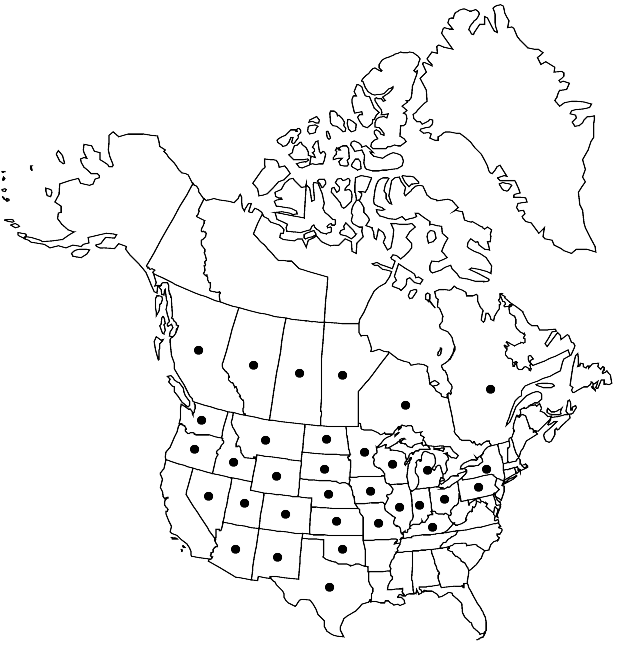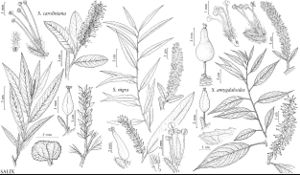Difference between revisions of "Salix amygdaloides"
Öfvers. Kongl. Vetensk.-Akad. Förh. 15: 114. 1858.
FNA>Volume Importer |
imported>Volume Importer |
||
| Line 8: | Line 8: | ||
}} | }} | ||
|common_names=Peach leaf willow | |common_names=Peach leaf willow | ||
| + | |special_status={{Treatment/ID/Special_status | ||
| + | |code=F | ||
| + | |label=Illustrated | ||
| + | }}{{Treatment/ID/Special_status | ||
| + | |code=E | ||
| + | |label=Endemic | ||
| + | }} | ||
|basionyms= | |basionyms= | ||
|synonyms= | |synonyms= | ||
| Line 50: | Line 57: | ||
|publication title=Öfvers. Kongl. Vetensk.-Akad. Förh. | |publication title=Öfvers. Kongl. Vetensk.-Akad. Förh. | ||
|publication year=1858 | |publication year=1858 | ||
| − | |special status= | + | |special status=Illustrated;Endemic |
| − | |source xml=https:// | + | |source xml=https://bibilujan@bitbucket.org/aafc-mbb/fna-data-curation.git/src/bb6b7e3a7de7d3b7888a1ad48c7fd8f5c722d8d6/coarse_grained_fna_xml/V7/V7_26.xml |
|genus=Salix | |genus=Salix | ||
|subgenus=Salix subg. Protitea | |subgenus=Salix subg. Protitea | ||
Revision as of 23:55, 27 May 2020
Trees, 4–20 m. Stems: branches flexible to ± brittle at base, yellow to gray-brown, glabrous; branchlets yellow-brown, gray-brown, or red-brown, glabrous. Leaves: stipules absent or rudimentary on early ones, foliaceous or rudimentary on late ones, apex rounded; petiole (margins covering groove, not glandular or with spherical glands distally), 7–21 mm, glabrous or puberulent adaxially; largest medial blade (sometimes amphistomatous), very narrowly elliptic, elliptic, lanceolate, or lorate, 55–130 × 24–37 mm, 2.8–6 times as long as wide, base convex, cuneate, or cordate, margins serrulate, apex acuminate to caudate, abaxial surface glaucous, glabrous, adaxial dull, glabrous or sparsely pubescent along midrib; proximal blade margins entire or shallowly serrulate; juvenile blade glabrous or pubescent abaxially, hairs white and/or ferruginous. Catkins: staminate 23–80 × 5–12 mm, flowering branchlet 3–28 mm; pistillate 41–110(–127 in fruit) × 8–16 mm, flowering branchlet 17–35 mm; floral bract 1.5–2.8 mm, apex acute to rounded, entire or toothed, abaxially sparsely to moderately densely hairy proximally, hairs wavy; pistillate bract deciduous after flowering. Staminate flowers: abaxial nectary 0.2–0.7 mm, adaxial nectary narrowly oblong to square, 0.3–0.8 mm, nectaries distinct; stamens 3–7; filaments hairy on proximal 1/2 or basally; anthers 0.5–0.6 mm. Pistillate flowers: adaxial nectary square, 0.1–0.6 mm; stipe 1.4–3.2 mm; ovary pyriform, beak slightly bulged below styles; ovules 16–18 per ovary; styles 0.2–0.4 mm; stigmas 0.24–0.31–0.4 mm. Capsules 3–7 mm. 2n = 38.
Phenology: Flowering early Apr–Jun.
Habitat: Moist to mesic floodplains, shores of lakes on sandy, silty, or gravelly substrates, marshes, wet sand dune slacks
Elevation: 60-2400 m
Distribution

Alta., B.C., Man., Ont., Que., Sask., Ariz., Colo., Idaho, Ill., Ind., Iowa, Kans., Ky., Mich., Minn., Mo., Mont., Nebr., Nev., N.Mex., N.Y., N.Dak., Ohio, Okla., Oreg., Pa., S.Dak., Tex., Utah, Wash., Wis., Wyo.
Discussion
Presence of Salix amygdaloides in Massachusetts, New Hampshire, and Vermont has not been verified; its occurrence in those New England states was reported by H. A. Gleason and A. Cronquist (1991), and by M. L. Fernald (1950).
Hybrids:
Salix amygdaloides forms natural hybrids with S. gooddingii and S. nigra. Hybrids with S. caroliniana (N. M. Glatfelter 1898) and S. eriocephala (M. L. Fernald 1950) have been reported; no convincing specimens have been seen. Controlled pollination between S. amygdaloides and S. eriocephala, S. interior, and S. petiolaris set no seed; controlled pollination with S. lucida produced a few seeds; some seedlings suffered necrosis in the cotyledon stage (A. Mosseler 1990).
Salix amygdaloides × S. gooddingii (S. ×wrightii Andersson): This hybrid occurs throughout the Rio Grande Valley, Texas, and New Mexico (C. K. Schneider 1919; C. R. Ball 1961), and at Happy and Rio Frio, Texas, and Virgil Run, Arizona. The leaves are somewhat glaucous abaxially, as in S. amygdaloides, but they are linear to narrowly elliptic and branchlets are sparsely pubescent as in S. gooddingii.
Salix amygdaloides × S. nigra (S. ×glatfelteri C. K. Schneider) resembles S. amygdaloides in leaves somewhat glaucous abaxially, but usually linear or narrowly elliptic, as in S. nigra. The stipules are not as prominent as in S. nigra but are foliaceous on late leaves; it should be expected wherever the ranges of the two species overlap. The hybrid is common in Missouri, where N. M. Glatfelter (1894) estimated that ca. 40% of the populations were hybrids, and in Illinois (R. H. Mohlenbrock 1980; G. Wilhelm, pers. comm.). Putative hybrids occur also in Ontario. Narrow leaves are typical of juvenile plants of S. amygdaloides but even at that stage they tend to be broadest at the midpoint or toward the base rather than in a midzone as in S. nigra.
Selected References
None.
